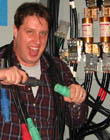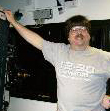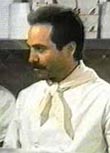|
|
This topic comprises 5 pages: 1 2 3 4 5
|
|
Author
|
Topic: Refersher on A-Chain
|
|
|
|
|
|
|
|
|
|
|
|
|
|
|
|
|
Randy Stankey
Film God

Posts: 6539
From: Erie, Pennsylvania
Registered: Jun 99
|
 posted 01-27-2011 03:16 PM
posted 01-27-2011 03:16 PM




quote: Scott Norwood
I assume that you have tried multiple prints to rule out printing issues or a bad mix, correct?
The print in question was "Chairo Time." I have not ruled out the fact that there was a problem with the soundtrack on the print but I am not 100% satisfied with my A-chain, either.
I did a "good" A-chain but, when I had problems, I rechecked it and found that my azimuth was just a hair bit off. I tweaked it and the problem got better but it didn't go away completely.
Here's how I understand the process:
On the Dolby CP-650 processor, you set Dolby levels with the green Dolby Tone film then switch to the pink film. At that point, you adjust azimuth using the scope. Then you switch over to the internal RTA of the CP-650 and adjust focus until the curve is as flat as possible on both channels. Bounce back and forth between focus and azimuth once or twice to be sure that you haven't knocked one out of line while setting the other.
After that point, you tell the CP-650 to auto-adjust for slit loss correction.
I did it all up to this point as well as I could. When I had trouble with the print, I rechecked it and found that I was just a tiny bit off. I retuned and it got better but not all the way gone.
I ran a bunch of trailers and didn't notice any problem. It only occurred on that one print of "Cairo Time."
I am going to retune the A-chain one more time and I'm going to be sure that I make it as good as possible.
In the last 10 years, I have only done A-chains a few times. It's not hard to do but takes a certain touch to get really good results. You guys do this kind of thing all the time. If I give myself some time, I'll get it right. I'm just rusty, that's all.
When I first did it, I'd score myself as 8 out of 10. I retuned it and got it up to 9. Now I want to go for 10.
quote: Darryl Spicer
Make your adjustments at the sound head and get the highest highs you can get on your anylizer and maintain a tight XY combination on your scope. Make sure the slit loss compensator is turned all the way down. Then make adjustments as needed on the compensator. You don't want the highs to peak above the other frequencies.
Are you saying to just screw the automatic setting and do it the old fashioned way? I don't have a problem with that, really. I somewhat prefer to do it that way but I wanted to do it by the book the first time. Then, once I learn the process, I'll go off-script.
So, set the slit loss at zero, tune the azimuth and focus then adjust the slit loss for "flat" and back off a click or two? Is that right?
That's pretty much the way I learned it before.
| IP: Logged
|
|
|
|
|
|
|
|
|
|
|
|
|
|
|
|
All times are Central (GMT -6:00)
|
This topic comprises 5 pages: 1 2 3 4 5
|
Powered by Infopop Corporation
UBB.classicTM
6.3.1.2
The Film-Tech Forums are designed for various members related to the cinema industry to express their opinions, viewpoints and testimonials on various products, services and events based upon speculation, personal knowledge and factual information through use, therefore all views represented here allow no liability upon the publishers of this web site and the owners of said views assume no liability for any ill will resulting from these postings. The posts made here are for educational as well as entertainment purposes and as such anyone viewing this portion of the website must accept these views as statements of the author of that opinion
and agrees to release the authors from any and all liability.
|

 Home
Home
 Products
Products
 Store
Store
 Forum
Forum
 Warehouse
Warehouse
 Contact Us
Contact Us




 Printer-friendly view of this topic
Printer-friendly view of this topic





![[Smile]](smile.gif)












